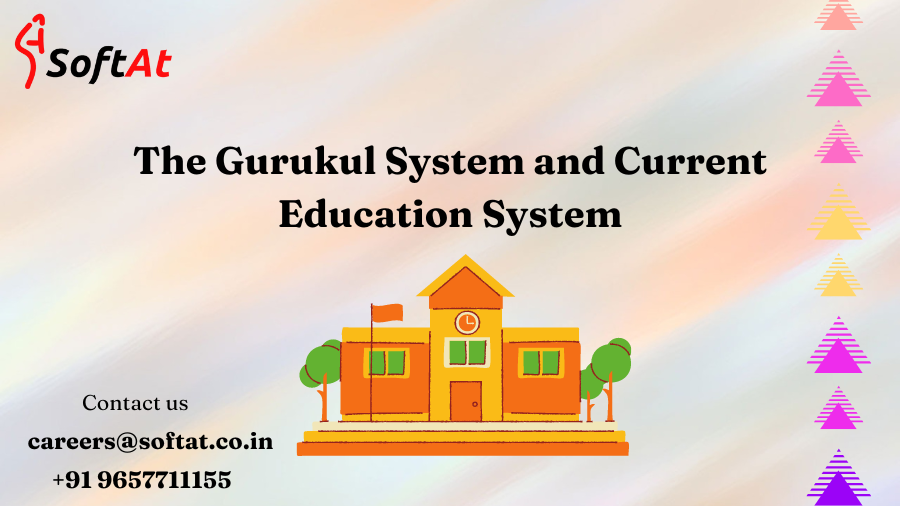Overview
The Gurukul system and current education system are two distinct approaches to education with their own advantages and disadvantages. The Gurukul system emphasized personal attention, moral values and practical skills, while the current education system focuses on academic subjects and provides access to technology. However, the current system can be impersonal and lacks emphasis on moral values. To create an effective education system, it is important to incorporate the best of both systems for a balanced approach.
The Ancient Gurukul System:
The gurukul system was an ancient educational system in India that was practiced for thousands of years. It was a unique system that combined the teachings of academics and moral values, and was based on the principles of guru-shishya tradition. In this system, students lived with their teachers (gurus) and were taught all aspects of life, including academics, physical and mental discipline, and moral values. The gurukul system played a crucial role in shaping the character and values of students and was considered the epitome of education in ancient India.
Here are some key aspects of the ancient gurukul system:
Residential in nature: Students lived with their teachers in gurukuls and were considered part of their guru’s family. This setup allowed for a close bond to form between the guru and the shishya, which was considered essential for effective learning.
Holistic education: The gurukul system aimed to provide a well-rounded education to students, covering all aspects of life, including academics, physical discipline, and moral values.
Guru-shishya tradition: The guru-shishya tradition was the cornerstone of the gurukul system. In this tradition, the guru was considered the ultimate authority and was revered by the students. The guru-shishya relationship was based on mutual trust and respect, and the guru imparted knowledge to the shishya through personal interactions and practical demonstrations.
Emphasis on character development: The gurukul system placed great emphasis on character development and instilled moral values such as honesty, compassion, and self-discipline in students.
Knowledge transmission through oral tradition: The knowledge imparted in the gurukul system was transmitted orally from generation to generation. This method of transmitting knowledge ensured that the teachings were not lost and allowed for the traditions and values to be passed down from one generation to the next.
Focus on practical skills: The gurukul system placed a strong emphasis on practical skills and students were taught a variety of subjects including mathematics, science, medicine, and martial arts.
Integration with nature: The gurukuls were typically located in serene and peaceful environments, surrounded by nature. This setup allowed students to be in touch with nature and to develop a deeper understanding and appreciation of the environment.

The gurukul system of education played a significant role in shaping the cultural and intellectual landscape of ancient India. It was considered one of the most comprehensive and effective systems of education and was widely revered for its emphasis on character development and practical skills. The system was so successful that it was adopted by several neighboring countries and was practiced for thousands of years.
The ancient gurukul system was a unique and comprehensive system of education that combined academics with moral values and practical skills. Its focus on character development, oral tradition, and close guru-shishya relationship made it an effective and well-rounded system of education. Despite its decline in recent times, the gurukul system continues to be remembered and revered as one of the most successful educational systems in history.
have you seen how SAP & Oracle Managed Services works ? click here
Current education system
The current education system is facing various challenges and changes in response to the rapid developments in technology and societal needs. The following are some key points highlighting the current state of education worldwide:
• Emphasis on STEM Education:
One of the main focuses of the current education system is on science, technology, engineering, and mathematics (STEM) education. This emphasis is due to the growing demand for workers in these fields and the need for a technologically advanced society. Governments and educational institutions are investing in programs and resources to enhance STEM education and encourage students to pursue careers in these fields.
• Integration of Technology:
Technology has greatly impacted the education sector, leading to the integration of digital tools and resources into classrooms. From online learning platforms to virtual classrooms, technology has made education more accessible and convenient. However, it has also brought about the challenge of ensuring equitable access to technology and ensuring that students are proficient in using these tools.
• Personalized Learning:
The traditional one-size-fits-all approach to education is becoming less effective, leading to the rise of personalized learning. This approach tailors the educational experience to each student’s individual needs, interests, and learning style. Personalized learning has the potential to improve student engagement, motivation, and outcomes.
• Emphasis on Soft Skills:
In addition to academic subjects, the current education system is also placing a greater emphasis on the development of soft skills such as teamwork, communication, and critical thinking. These skills are highly valued by employers and are essential for success in the modern workforce.
• Growing Importance of Vocational Education:
As the economy shifts towards a greater emphasis on technical and trade jobs, vocational education is becoming increasingly important. Vocational education programs provide students with the practical skills and knowledge needed for careers in specific industries such as healthcare, construction, and manufacturing.
• Challenges of Online Learning:
The shift towards online learning as a result of the COVID-19 pandemic has brought about new challenges for the education system. These include unequal access to technology, difficulty in fostering a sense of community, and ensuring that students receive the same quality of education as in-person learning.
• Importance of Mental Health Support:
The current education system is also placing a greater emphasis on the importance of mental health and well-being. With the increasing stress and pressure faced by students, it is crucial for schools to provide support and resources to address mental health issues.
• Equity and Inclusion:
The current education system is also facing the challenge of ensuring equity and inclusion for all students. This includes addressing disparities in educational opportunities and outcomes based on race, socio-economic status, and other factors.
The current education system is undergoing significant changes in response to technological advancements and societal needs. While these changes bring new opportunities and innovations, they also bring new challenges that must be addressed to ensure that all students have access to a high-quality education.
Conclusion
In conclusion, both the Indian Gurukul system and current education system have their own unique strengths and weaknesses. The Gurukul system emphasized personalized attention, moral values, and practical skills, while the current education system focuses on scientific and technological advancements and provides a more comprehensive curriculum. However, the current education system faces challenges such as unequal access to resources and a lack of focus on moral and ethical values.
It is important to learn from the strengths of both systems and strive for a balanced approach that incorporates the best of both worlds. This can include incorporating traditional values and practical skills into the modern curriculum, while also providing access to cutting-edge technology and resources. By doing so, we can create a more holistic education system that prepares students for success in all aspects of life.





